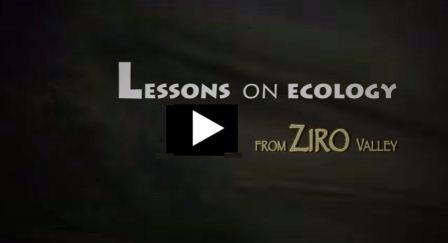Aquaculture in Apatani plateau in Arunachal Pradesh
Aquaculture in Apatani plateau in Arunachal Pradesh

This Video Explains about Inhabited by the Apatanis, Ziro valley in Arunachal Pradesh is perched at a height of 5600 ft. For anyone who wants to understand sustainability, the unique Ziro valley is an institution in itself. The valley is known for its paddy cum fish agriculture and traditional water management practices. Watch the video to know more.
Rice-Fish culture Practice in Apatani Plateau
The Apatanis practice aquaculture along with rice farming on their plots. Rice - fish culture in the valley is an unique practice in the state, where two crops of rice (Mipya and Emoh) and one crop of fish (Ngihi) are raised together.
Integrating aquaculture with agriculture assures higher productivity and year round employment opportunities for farmers. Organic inputs are used in the plots utilised for rice cum fish culture. Some of the inputs used are poultry dropping (Paro pai), pig excreta (Alyi ekha), cow dung (Sii ekha) and wastes of plants such as rice husks (Piina), ashes from household stoves (Mubu) and remains of burnt straws (Muyu) and decomposed straw (Liisi), weeds (Tamih) and stalks (ankho).
Advantages of this practice
The rice field (Aji) can be utilized for fish culture in the following two ways.
- Fishes can be reared from the month of April to September when the paddy crops grow in the field.
- The fish culture can also be taken up from the month of November to February after harvesting of paddy crop
Paddy fields with strong bunds are essential for fish culture. Strong bunds (Agher) prevent leakage of water, help retain water to a desired depth and also prevent the escape of cultivated fishes during floods. To support the bunds, bamboo mating is done at the base. Cultivation of millets (sarse) on the bunds is a common practice in Apatani pleteau. Bunds can also be utilised for cultivation of several vegetables, like cauliflower, cabbage, tomatoes, radish, pumpkin, cucumber, beans, brinjals chillies, ginger etc
The channels (Siikho/Parkho/hehte) in the paddy field are used for water management. They are constructed at the middle of the paddy fields in such a way that they divide the paddy field vertically and horizontally. The parkho provides the rearing space for fishes. It also serves as the shelter for fishes during the sunny day. The paddy fields generally have two outlets (hubur) and one inlet. One outlet is used for over flow of water and the other is meant for draining of the water during harvest of paddy and fishes.
Present status
In recent years, insecticides, pesticides, weedicides, and fungicides, many of which even in minute quantities, are highly toxic to aquatic life are being used. In such cases, fish culture is generally taken up during the off season or after harvest of paddy. In paddy cum fish culture, along with common carp, catla, rohu and mirgal are also being cultivated. In this, stocking density is maintained at the rate of 5000 fingerlings/ha. The species constitutions include surface feeders (25%), column feeders (30%) and bottom feeders (45%).
Source : http://lowersubansiri.nic.in/html/paddyfish_culture.htm
Last Modified : 3/1/2020
This topic provides information about Atal Jyoti ...
Technologies developed by various research institu...
This topic provides information about Municipal E...
This topic contains information about the National...
